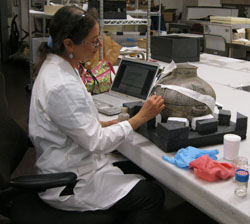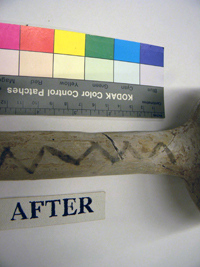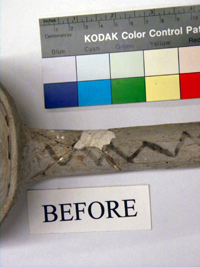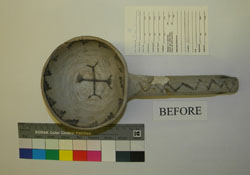Story
Artifact Conservation for Living West
Leading up to the November opening of Living West, collections and curatorial staff made sure many of History Colorado’s most treasured artifacts were ready for display. Several pieces from our world-class Mesa Verde collection are now on view, including ceramics and basketry that are more than 500 years old. Artifacts may require repairs, cleaning, or other treatments to be safe and look their best for exhibit, so checking item conditions is a crucial part of the process. We must also compare conditions before and after the exhibit to make sure items are not harmed as a result of being on display.
Over the summer, History Colorado brought in local objects conservator Judy Greenfield to review fragile collections and ensure they would be safe while on exhibit. Greenfield has extensive experience working with archaeological artifacts, and she’s treated many collections already on exhibit, including the much-loved Denver Diorama. Greenfield consulted with our staff to reinforce or stabilize old ceramic repairs, better support and stabilize some of the baskets, and ensure that items selected for display were ready for the new exhibit.
Each item requires a unique treatment. When treating ceramics, conservators often see 30+ year-old repairs that used adhesives which are failing, joined incorrectly, or just need to have excess adhesive cleaned. When treating basketry, we may see loss of structural integrity and collapsing weak spots due to loss over time or inherent vice of the material.
Visitors may still see some of the conservation treatments while theo_2012_1_beforeOP artifacts are on exhibit. Conservation is not meant to erase imperfections; rather, a conservation treatment aims to stabilize the item’s condition. Some cracks or other condition flaws are left visible (but made stable) because they are part of the history of the artifact. The artifact may have been cracked during firing or during use over 500 years ago. Rather than erase or “fix” such condition flaws, conservators stabilize and maintain these fine details to reflect the item’s history.
Take a look at the examples of object O.2012.1. Some photos show cracks and areas of loss that were stabilized but still visible, and some include flaws that are masked. Can you see the differences? Be sure to visit Living West to see if you can find other examples.




